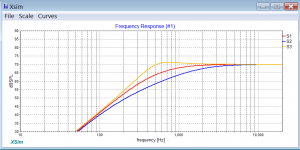I’m attempting to build a 3 way speaker using pre made crossovers. Is it correct that I would need 4ohm woofers wired in series so that the crossover see’s the 8 ohm load it‘s rated at. And it would be the same for the midranges ?
Thank you for helping.
Thank you for helping.
The designations '4 ohm' and 8 ohm' are called 'nominal impedance' - they are not the actual impedance of the drivers, which vary with frequency. (Look at some manufacturers driver spec sheets, which include an impedance plot, and you'll see what I mean). For this reason, 'pre-made crossovers' are no help. Crossovers need to be designed for the actual impedance of the drivers at the crossover frequencies. There is a way to correct impedance to 'nominal' using Zobel Networks, but again, the way this is done depends on the parameters of the individual drivers being used.
Yeah, without measurements all one can do is use the published impedance plots and add reactance annulled Zobels.
That’s what I’m kinda doing, just winging it the best I can. I was just curious though because if I wired 2 8 ohm woofers in series that would be 16 ohms total. If the crossover is rated 8 ohm on the low side it would see the 16 ohm load and would that drastically change the sound ?
I should probably pickup a speaker design book before I proceed any further.
I should probably pickup a speaker design book before I proceed any further.
I've shown here the effect of using a crossover with different loads. The middle is the 8 ohms it was designed for, the others are 4 and 16.
This is a second order crossover and this is what many pre-made crossovers are. Unlike first order pre-made crossovers, 2nd keep the same slope/frequency when you use a different load impedance, which is why they're more often used. Their difference is around the 'knee' near the crossover frequency.

This is a second order crossover and this is what many pre-made crossovers are. Unlike first order pre-made crossovers, 2nd keep the same slope/frequency when you use a different load impedance, which is why they're more often used. Their difference is around the 'knee' near the crossover frequency.
